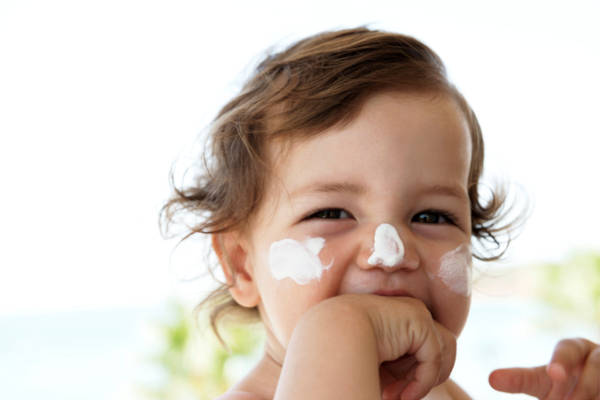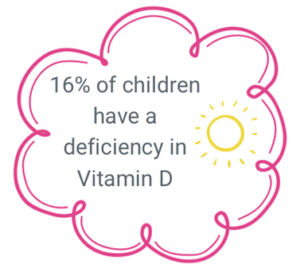Summertime in nurseries can make all outdoor activities more enjoyable. But fun in the sun can also bring hidden danger. We share all you need to know about sun safety in the early years, from why sunlight is essential to the hidden risks, and some easy tips to remember when promoting sun safety for kids.

All you need to know about sun safety in the early years
Why is sunlight important to children?
Sunlight is essential to us all, secretly working to keep our bodies healthy and ticking along nicely. There are both direct and indirect benefits from being outside in the sunshine.
The direct benefits help our bones, immune system, and muscles develop and repair, keeping us fighting fit. We also scoop up all of the indirect benefits from being outside, moving and taking in the sensory feast that is nature.
Vitamin D and sunshine
Vitamin D is often known as the sunshine vitamin. It’s an appropriate name, because when our bodies are exposed to Vitamin D through sunshine (or via foods or supplements), it helps them absorb calcium and phosphorus and fix Vitamin C to our bones.
Calcium is needed to grow strong bones and aid muscle development and repair. This is why children require a higher amount of Vitamin D than adults. Deficiency in the sunshine vitamin can lead to weak bone formation and growth (like the condition rickets).

The NHS recommends that children between the ages of 1 and 4 (breastfed or taking less than 500ml of formula) take a daily Vitamin D supplement – a valuable nugget of information to share with your parents!
Sensory experiences
All children should have access to sensory activities to boost their development. Babies and toddlers of all ages should be outside and experience the senses in action, such as lying under a tree with the leaves moving in the breeze.
Clare Stead (Founder of the child development activity app Olikii) notes that these simple and easy activities are pivotal in a child’s sensory development. Want to learn more about the first 1000-day of life and learning? We have a blog for that!’
Movement
We know that children in early years are encouraged to experience all their senses when playing outside. Of course, it’s preferable in the sunshine, but we are based in the UK after all!
When children are exposed to sunlight (not direct sunlight), they can indirectly improve their fine and gross motor skills, social development and even scientific knowledge due to seasonal changes.

What are the dangers of sun exposure for children?
Nursery practitioners are responsible for the safety of all of the children in their care, but of course you know that! Sun exposure is a safety risk that can catch practitioners off guard and have lasting effects on children’s health.
Did you know that just one sunburn that results in blistering in childhood can double the risk of developing melanoma (skin cancer) in adulthood?
Sunburn is the most common danger associated with sun exposure for children. Sun cream should be applied every 2 hours (ensuring it is a high enough factor for their skin type). However, EYFS activities like water play can easily wash off suncream (including those that recommend application once daily).
Children with sensitive skin and less melanin (like fair skin) are more vulnerable to sunburn and should have a high-factor sun cream provided by the parents. More on parents providing sun cream a little further down!
When a child or baby has been in the sun or heat for a prolonged period, they can develop heat stroke. Heat stroke is a serious condition and can result in hospitalisation.
Your staff must know how to spot the signs of and prevent heatstroke in children and babies. They should also know what information to share with parents if there are concerns that a child has been exposed to too much sun.
Parents and sun cream in nurseries
Most nurseries operate a suncream policy, where parents provide the suncream they choose for practitioners to apply throughout the day. It can be useful to share your sun safety policy with your parents when they start with you and again when the months get warmer.
A common expectation is for parents to apply the first application of suncream of the day before they come to the nursery. Practitioners can re-apply the sun cream when necessary (the guidelines are every two hours).
Top Tip: Parents should still provide sun cream for their child even if they use the once-a-day application type.
Tips to stay safe in the sun for early years
We have collated all the top tips for sun safety in the early years, helping you keep the children safe and enjoy the nice weather.
Wear sun cream
We know that sun cream is one of the top non-negotiables when it comes to sun safety for kids. When sunshine and heat are forecast (even on cloudy days), parents must be reminded to slather their children up before the nursery day begins.
Sun cream with a high SPF (sun protection factor) and UVA 5-star rating should be used. It is recommended that children use sun cream with a minimum of 30 SPF regularly throughout the day. Remember, children can still be exposed to harmful UV rays even on cloudy days.
Top Tip: Mobile weather apps often note the UV ray potential on sunny days. This can help you be extra safe and prepared on cloudy summer days.
Sun cream application for children and babies:
- Sun cream should be applied regularly throughout the day (every 2 hours as a minimum)
- You should wait 15-30 minutes after applying sun cream before going out into the sunlight
- Take care when playing with water, towelling or changing clothes after sun cream application as it may rub some off
- Use a high SPF coverage to avoid sunburn

Avoid peak times
Children and babies should not be out during the hottest part of the day, between 11 a.m. and 3 p.m. daily. During this time, stick to shady areas and have regular breaks indoors where there is good ventilation and maybe a fan or two on.
Top Tip: Heatstroke doesn’t necessarily need sunlight, as it's hot temperatures that children’s bodies struggle with.
It is also useful to note that children who experience sensory differences may struggle to regulate and recognise their own temperature. Don’t always rely on a child’s own response to whether they are feeling too hot or thirsty; this could result in heatstroke.
Promote sun safety
Sun safety for kids should be regularly shared with parents. Primary schools now have sun safety as a mandatory part of their curriculum, and the early years should follow suit. Sharing sun safety tips with parents via your Parent App is an easy way to promote healthy habits in the sunshine.
Share your sun cream policy with parents
Your sun cream or sun safety policy should highlight your nursery’s expectations when it comes to what parents should provide for their child. Ensure your parents have access to all of your important nursery policies from the very beginning. It can be helpful to send out reminders on the morning of hot weather via your Parent App.
Stay hydrated
Liquid is essential during warm weather. As the body sweats to keep cool, dehydration can occur. Encourage young children to stay hydrated as part of your sun safety practices. During the summer months, having a water station where children can access their water bottles or tap water whenever they’d like can be useful.
Top Tip: Ensure good hygiene practices and give children a named beaker or encourage them to drink from their own water bottles.
Record when sun cream has been reapplied
Keeping parents informed via their daily diaries helps build trusting relationships. In the notes and activities sections, keep parents in the loop when sun cream is reapplied. Then, if an impromptu park trip follows nursery pick-up time, the child’s sun safety is covered.
Summertime in nurseries is excellent fun! Give parents confidence and promote sun safety with kids in an easy way.
Share this article with your workmates and maybe even your setting’s parents!